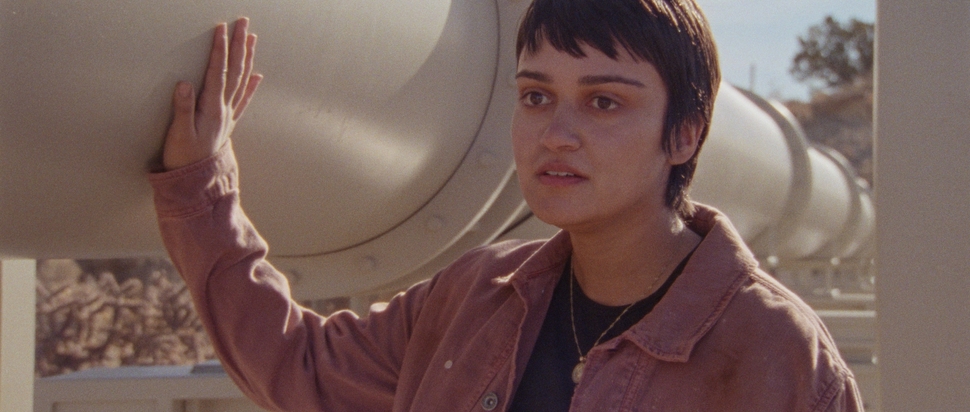Tick Tick Boom: Meet the team behind How to Blow Up a Pipeline
How to Blow Up a Pipeline might be the most important film of the year. It's certainly the most thrilling. We speak to the director and editor behind this nailbiting eco-thriller that's also a stunning political statement
Every once in a while a film comes along that seems mainlined into the zeitgeist. How to Blow Up a Pipeline, the blistering new work from director Daniel Goldhaber, is one such film. It’s a ticking time bomb thriller that speaks directly to our current moment where climate change is rapidly having devastating effects on our planet.
The story follows a group of incredibly good-looking young people drawn from all across America who have gathered in Texas to blow up a key oil pipeline. The film is adapted from Andreas Malm’s nonfiction book of the same name, which takes the form of a political manifesto that argues the next moral step in climate change activism must be industrial sabotage against the capitalist entities causing the climate crisis.
An academic text isn’t the obvious source material for the most exciting film of the year, but Goldhaber's ingenious adaptation has turned Malm’s political ideas into a breathless nailbiter that evokes myriad classic thrillers, from Michelangelo Antonioni's Zabriskie Point to Henri-Georges Clouzot's Wages of Fear, while simultaneously feeling fresh and utterly of the moment. Appropriately for a film about collective action, the writing of How to Blow Up a Pipeline was very much a group effort, with Goldhaber joined on story duty by editor Daniel Garber, executive producer Jordan Sjol and producer and actor Ariela Barer.
“I think the project, more than anything was born out of a political moment,” says Goldhaber when we meet him in Glasgow ahead of How to Blow Up a Pipeline’s UK premiere at the city's film festival. “We were all coming out of a year of lockdown, and a year of feeling extremely politically, creatively and professionally powerless. We all wanted to make something but it had to be something that's actually relevant. So this idea of taking a leftist manifesto and bringing it into the mainstream, now felt like it was a very appropriate moment to do that."
It was Jordan Sjol who initially brought the leftfield source material to the table. “Jordan is an academic,” explains Goldhaber, “and he had always wanted to adapt an academic text into a film – I think half-jokingly, half-not.” Sjol initially recommended Malm’s book to Goldhaber and Barer as a reference for another project they were working on, but Goldhaber quickly realised it had more potential. “I started reading it and immediately had this image of some kids in the desert struggling with a bomb,” he recalls. “It was just one of those lightning bolt moments.”
If we were to use one single word to describe How to Blow Up a Pipeline it would be urgent: in both its political message and its pacing. Partly to thank for the latter is the film’s ingenious structure, which intermittently pauses the nerve-shredding execution of the group’s sabotage to flashback to quieter moments revealing the individual circumstances that brought each character to take this radical action.
Editor Daniel Garber joins Goldhaber in Glasgow and reckons this breakneck pace was a natural consequence of the film’s whirlwind production. “I do think that this is an example where everything that's happening behind the scenes really affects the way that something comes across on screen,” he says. “I mean, it felt like pulling off a heist to actually make the film. It was incredibly quick from conception to delivery. I think Danny first talked to me about it about 18 months before we premiered the film.” The pacing Garber adopts in the edit also takes influence from his and his colleagues’ anxiety about the climate. “A lot of the sense of urgency that we feel around climate change and around taking some kind of meaningful action really translated into the sense of rhythm that the editing communicates,” he says.
The result is the most exciting American film of the year. But as well as being a great night at the movies, How to Blow Up a Pipeline is also an energising piece of art. You walk out of the film vibrating, riled up, ready to make your own mark on the world. You might even wanna blow up a pipeline – so detailed is the execution of the plan in the film, you probably could. And this is exactly the feeling that Goldhaber is hoping to elicit. “The movie was absolutely conceptualised as a counterpoint to doomism,” he says.
Goldhaber points out that what often makes people feel so powerless regarding the climate crisis is that there is no one government, business, or system that we can focus our energy on because everyone participates in climate change, to some greater or lesser extent. But the genius of Malm’s manifesto – and by extension Goldhaber’s film – is that it gives us a target: the infrastructure; the machines that are killing us. “I think that’s empowering,” he says. “It's important for me, even in the face of all of the inaction, even in the face of increasing extreme weather events and deaths and all of that, that we’re not apathetic. And if you do look at the historical record, by that standard, we haven't even really started to fight. And I think it's in that idea, that there’s still a sense of hope.”
How to Blow Up a Pipeline is in cinemas now
Listen to the full interview with Daniel Goldhaber and Daniel Garber on The Cineskinny, The Skinny's film podcast, available on Spotify, Apple Podcasts, or wherever you get your podcasts
